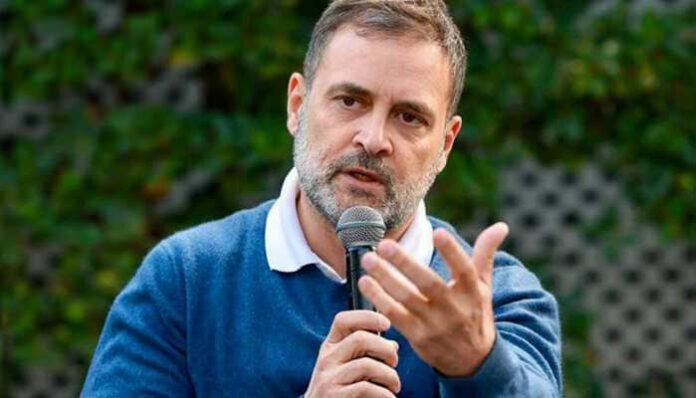On a crisp morning at IIT Madras, a sense of anticipation filled the air as Congress leader Rahul Gandhi prepared to address a gathering of students and educators. It was not just a political event; it felt like a conversation with the nation’s youth about their dreams, challenges, and the role education plays in shaping their future. What unfolded that day was more than a speech—it was a heartfelt dialogue that placed ordinary people at the heart of the conversation about India’s education system.
The Seeds of Change
Rahul Gandhi began by recounting a visit to a remote village in Madhya Pradesh a few months earlier. Sitting on a simple charpoy, he had listened to the aspirations of a farmer’s daughter, Meena, who dreamed of becoming an astronaut. Her eyes lit up as she spoke of the stars, but her voice faltered when she mentioned her school’s broken laboratory equipment and the lack of resources to prepare for competitive exams. “Why should Meena’s dreams be smaller than those of a student in a metropolitan city?” Gandhi asked the audience at IIT Madras, his voice resonating with conviction.
This question, he explained, lay at the heart of his vision for education reform. “Education is the bridge between dreams and reality,” he said, “and it is the government’s responsibility to ensure that this bridge is strong, inclusive, and accessible to everyone.”
The Systemic Flaws
Rahul Gandhi’s critique of the current education system was sharp yet empathetic. He described it as restrictive, focused on rote learning, and overly geared toward a narrow set of careers like engineering and medicine. “Our system defines success in such limited terms,” he remarked. “It’s like telling children they must all fit into one mold, regardless of their unique talents and passions.”
He spoke of the psychological toll this takes on students, recounting conversations with young people across India who felt trapped in a system that prioritized marks over learning and competition over collaboration. Gandhi’s words struck a chord with students at IIT Madras, many of whom nodded in agreement.
A Farmer’s Perspective
From the bustling corridors of IIT Madras, Gandhi’s narrative shifted to a small farming community in Bihar. Here, he had met Ramesh, a middle-aged farmer struggling to educate his three children. Ramesh’s eldest son, Anil, had dropped out of school to work in the fields because the family couldn’t afford tuition fees for a private school. The government school in their village was understaffed, with teachers juggling multiple grades in a single classroom.
“Ramesh doesn’t want charity,” Gandhi told the IIT audience. “He wants a robust public education system that ensures his children get the same opportunities as those in urban India.”
The crowd murmured in agreement, and Gandhi continued. “This is not just Ramesh’s struggle. It is the struggle of millions of parents who believe in the transformative power of education but are let down by the system.”
The Vision for Reform
Rahul Gandhi’s vision for reform was both pragmatic and aspirational. He outlined several key pillars:
- Increased Government Spending Gandhi emphasized the need for significantly increased public investment in education. “Quality education cannot be left to the whims of privatization,” he argued. “We need to strengthen our public institutions so that every child, regardless of their socio-economic background, has access to excellent education.”
- Broadening Career Horizons He called for a shift in how success is defined, advocating for an education system that values diverse talents and career paths. “Why should a child’s worth be measured only by their ability to crack engineering or medical entrance exams?” he asked.
- Fostering Creativity and Innovation Gandhi proposed an overhaul of the curriculum to nurture creativity and critical thinking. “We must move away from rote learning and create an environment where children can explore, experiment, and innovate,” he said.
- Equitable Resource Distribution Drawing a stark contrast to the BJP’s trickle-down economic model, Gandhi advocated for fair resource distribution. “A harmonious society is one where opportunities are equally distributed,” he noted. “This is not just a moral imperative; it is essential for national progress.”
A Teacher’s Tale
During his speech, Gandhi shared the story of Anjali Sharma, a dedicated government school teacher in Rajasthan. Despite limited resources, Anjali had transformed her school by introducing creative teaching methods and fostering a love for learning among her students.
“Teachers like Anjali are our unsung heroes,” Gandhi said. “Imagine what they could achieve if we provided them with the tools and support they deserve.”
His words drew applause from the audience, many of whom were inspired by Anjali’s commitment.
The Role of Common People
At the heart of Gandhi’s vision was a belief in the power of ordinary citizens to drive change. He spoke of community-led initiatives where parents and local leaders had come together to improve the quality of education in their villages. “When people take ownership of their schools, miracles happen,” he said. “This is the kind of participatory approach we need to scale across the country.”
He also called for students and youth to play a proactive role in shaping the future of education. “Your voices matter,” he told the IIT students. “You have the power to challenge the status quo and demand a system that works for everyone, not just a privileged few.”
Contrasting Philosophies
Gandhi’s speech also drew a sharp contrast between his vision and the BJP’s approach to education. He criticized the current government for focusing on market-driven solutions and failing to address systemic inequities. “Education is not a commodity,” he declared. “It is a fundamental right, and treating it as a business will only deepen the divides in our society.”
He further critiqued the trickle-down economic philosophy, arguing that it has not delivered the promised benefits to India’s marginalized communities. “We need a bottom-up approach that empowers every citizen,” he said.
The Road Ahead
As the session concluded, Gandhi’s parting words left a lasting impression. “The change we seek will not happen overnight,” he acknowledged. “But every step we take to strengthen our public education system brings us closer to a future where every child’s potential is realized.”
The students rose to their feet, applauding not just the ideas shared but the sincerity with which they were delivered. Outside the auditorium, discussions continued as young minds debated and reflected on the role they could play in shaping India’s educational landscape.
Empowering the Nation
Rahul Gandhi’s interaction at IIT Madras was more than a policy pitch; it was a rallying cry for collective action. By centering the voices of common people—from farmers and teachers to students and community leaders—he underscored that the journey toward educational reform is one that belongs to everyone.
In the months that followed, his vision sparked conversations across the country. Villages organized meetings to discuss school improvement plans, students launched campaigns demanding better facilities, and teachers shared innovative ideas on social media. Gandhi’s words had lit a spark, and it was clear that the people of India were ready to transform their dreams into reality.



